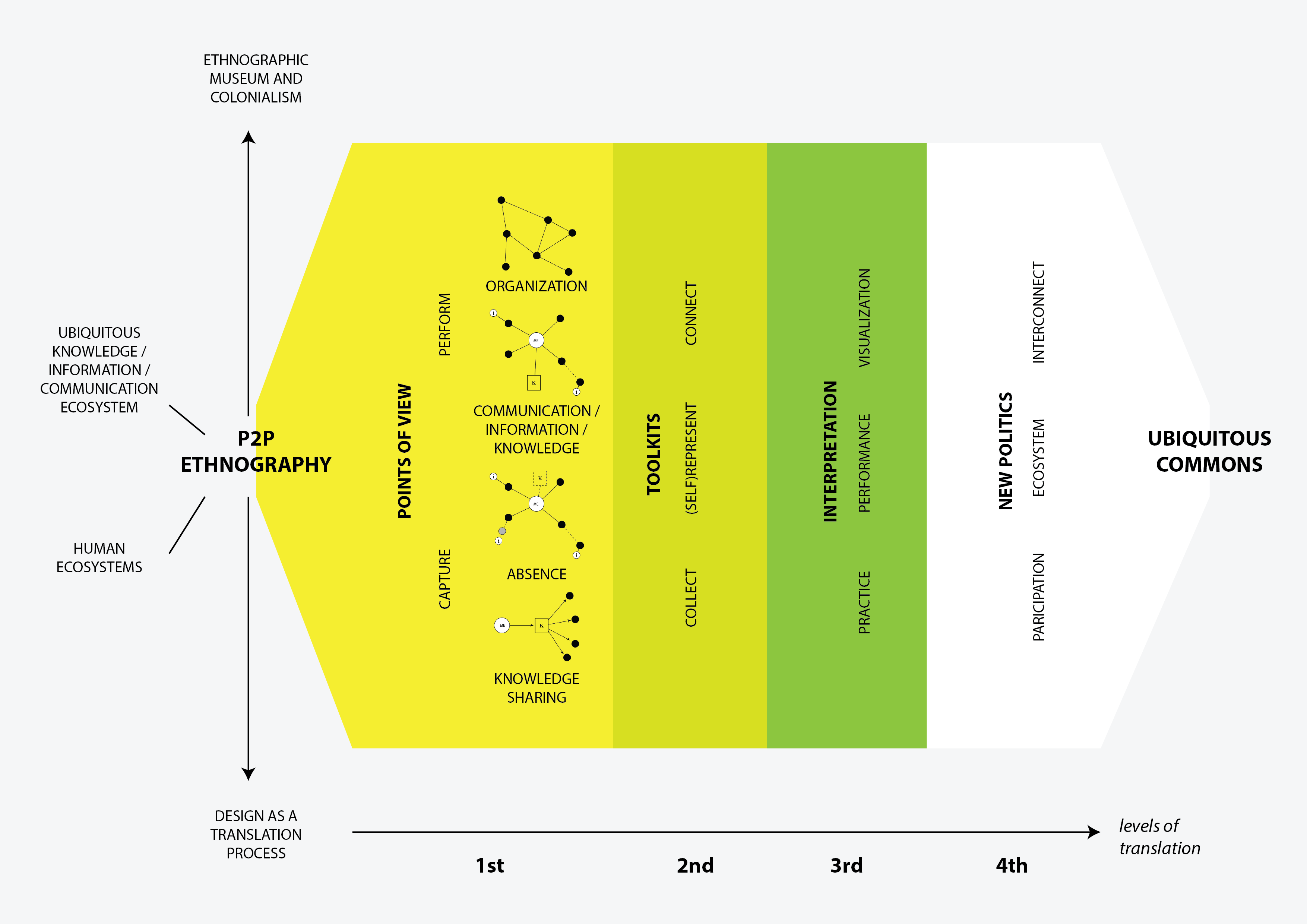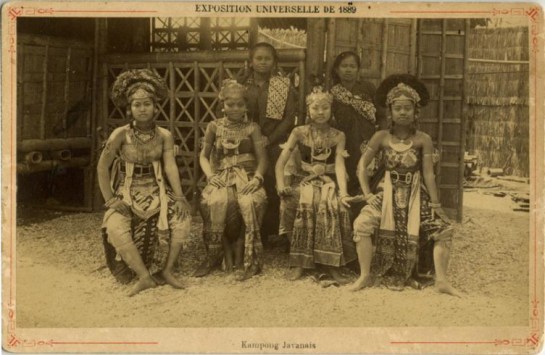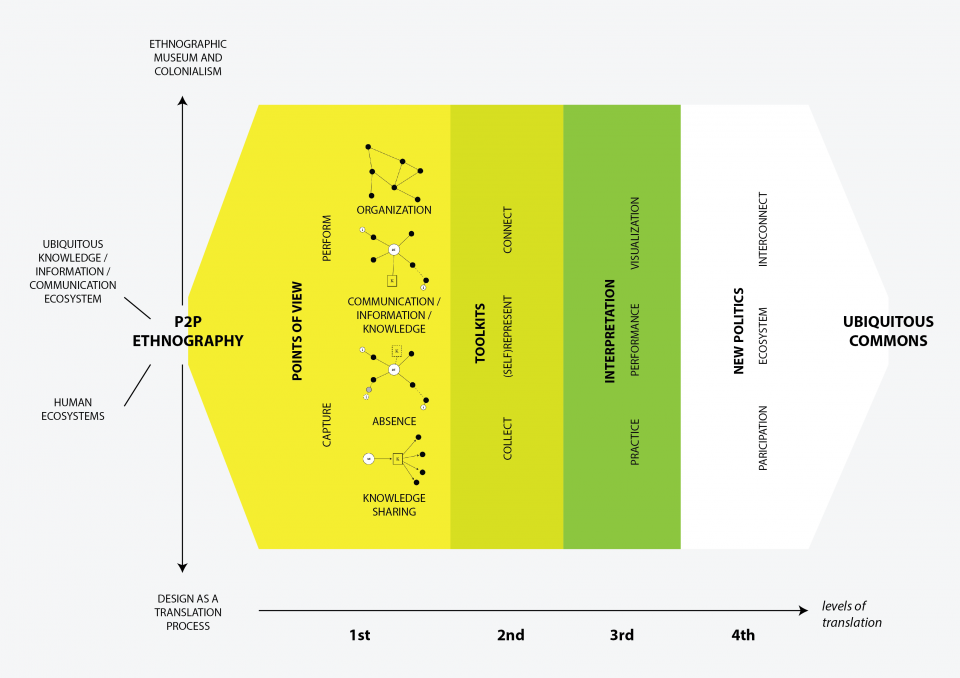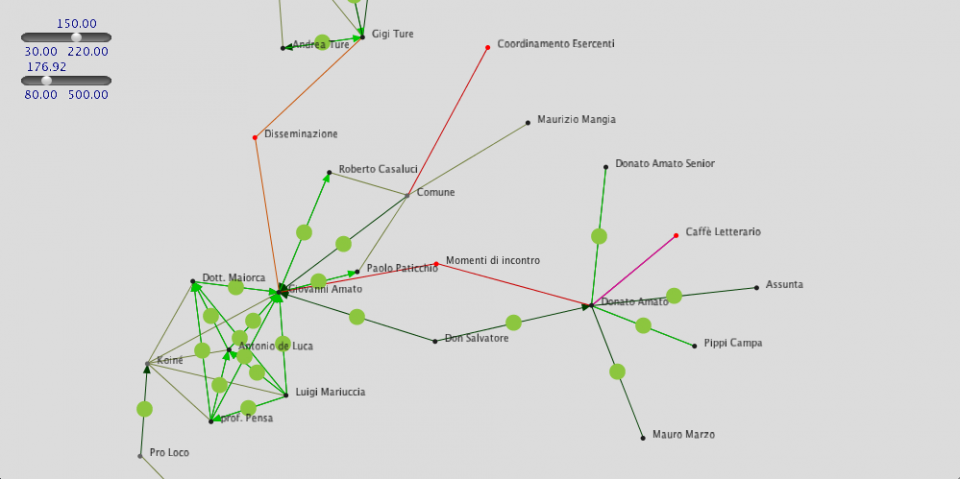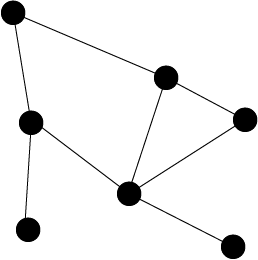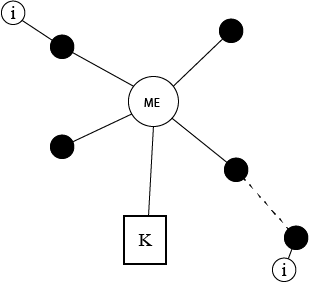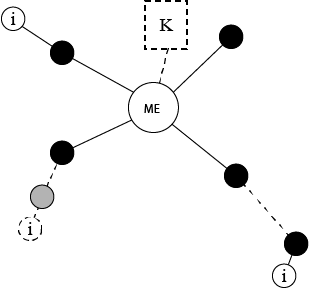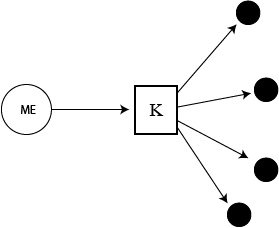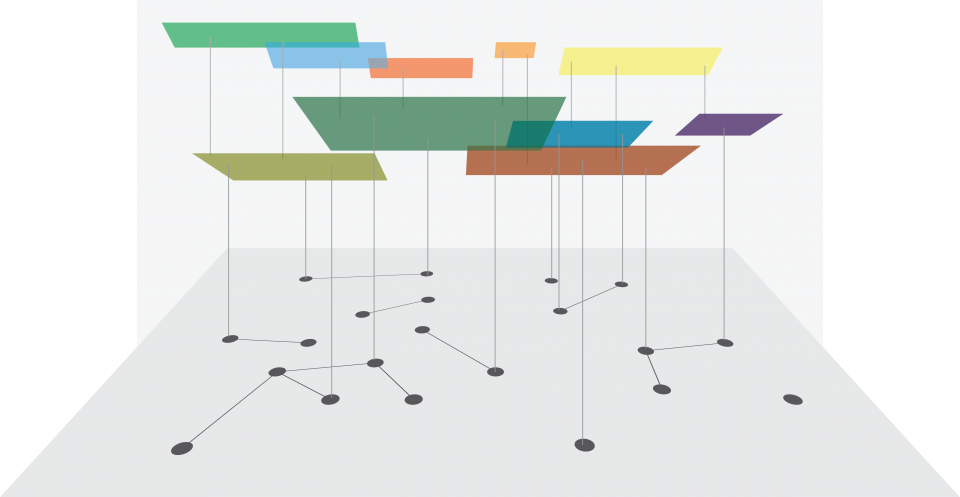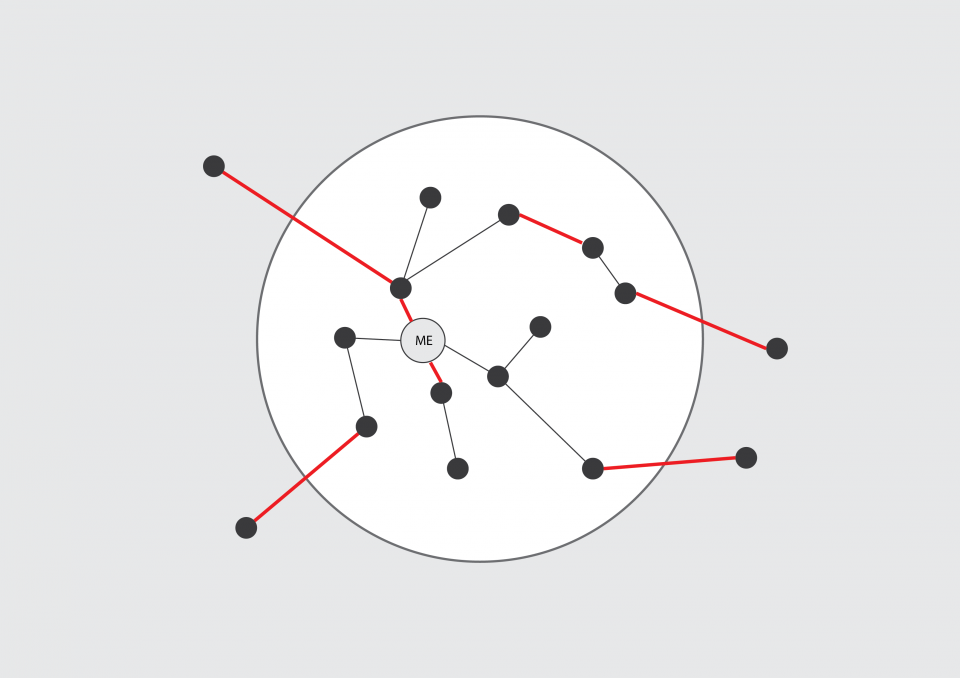[this article originates from our participation to XYLab, in Castrignano de’Greci, Puglia, Italy]
Introduction
In Universal Exhibitions from the end of the ‘800s and beginning of the ‘900s, indigenous people were often exposed – under glass houses, in cages or using a variety of media and artefacts – for the entertainment of other people, as if they were objects.
For example Paris’ Exposition Universelle of 1889 featured an entire Negro Village, which was among the Exposition’s main attractions.
These were storytelling exhibits, telling the stories of far-away, “Other”, alien people, by trying to narrate them through images, objects and entire re-created environments, and turning them into an entertainment experience for amused visitors and consumers.
They were often also stories about possibilities: futures and things which we, the colonialists, had imagined for them, the aliens, the Others. In fact the objective was, many times, to highlight the “civilising” influence of colonialist rule, and the supposed ways in which colonialist influence would have been able to bring about new economies and roles for these people (for example: Apache chief Geronimo selling his autograph in the Primates section of the Bronx Zoo).
Much has happened since those times, including the fundamental intuitions and practices coming from Lévi-Strauss, Malinowski, to Bateson, Mead, Clifford, Geertz, Bhabha and the many more with which ethnography has understood many lessons, including the ones of self-representation, the importance of performance (of all parties involved, and with all parties involved being able to choose the rules of the game, not having to adapt to a scheme decided by the ethnographer, in polyphonic ways, with a number of different voices, evenly distributed between the ethnographers and the people, from their own point of view).
In the Digital Age, the age of Communication, Information and Knowledge, the possibility to capture, express, observe, visualize and understand the patterns for behaviour, emotion, opinion, expression, movement and more, potentially for hundreds of millions of people at a time, has brought the term “ethnography” in the spotlight for both academic and popular crowds.
This is also among the results of the rise of the creative classes, among the leading driving forces for economic development of post-industrial cities. The Creative Class is constantly engaged in a wide variety of design related processes for which certain domains of ethnographic research are of fundamental interest, both at the direct (observation and understanding of user bases) and meta (understanding of the Creative Class itself) levels.
Also of importance is the need to understand the ways in which the logics of entertainment, in the age of the prosumer can drift towards the logics of self-colonialism: the prosumer often becomes a consumer that consumes itself through acts of creative production whose results contribute to the benefit of large operators, who provide the expressive frameworks and schemes, and who are the only ones able to intercept, harvest, understand, interpret and represent the value being produced.
This, in many cases, results in a state of self-colonialization, in which prosumers act within a set of diverse boundaries (perceptive, identity, cognitive, economic, service) which are perceived as performative public spaces, but which are not, and whose benefits mainly go to the advantage of large operators.
In this frame, we can conceptualise a scenario which is more sustainable, clear, open and free by introducing a series of concepts which refer to ecosystemic logics, which are more polyphonically performative, and which are based on novel definitions of value and on a use of knowledge sharing tools and practices which is more aware and which does not re-enact colonialist logics and, instead, focuses on the possibility and value for self expression, representation and performance, and on the multiple types of economies which can be generated from this.
Human Ecosystems & Ubiquitous Knowledge Ecosystems
We want to address this scenario starting from the opportunities offered by the possibility to study micro-histories, and from the importance of understanding communication, information and knowledge flows in cities.
Micro-history, to leverage the driver of the well-being of any ecosystem: its biodiversity (cultural biodiversity, in this case).
Communication, information and knowledge flows, to be able to perform Digital Urban Acupuncture: a form of relational intervention whose aim is to identify these flows and their interruptions, to discover those localised pressure points which can be engaged to establish new dynamics, create bridges and, possibly most important of all, to enable the emergence of a Communication, Information and Knowledge Commons: a perceivable, accessible, usable environment which is inclusive and free, thus being able to promote the rise of a variety of different, resilient economies.
Through the Human Ecosystems (here, as well, on Art is Open Source) project we have described and implemented a series of open approaches, methodologies, tools and practices whose intent is to enable people, citizens, organisations, administrations and companies to freely observe, use and perform the relational ecosystems of entire territories (wether they are geographic, topic-based, networked…) from the points of view of emotions, relations, issues, interactions, communication, information and knowledge. This is a radical approach in which the logics of consensus are replaced by the ones of ecosystemic co-existence.
These dynamics integrate the discourse about the possibility to design a Near Future Education scenario (the Near Future Education Lab is also here on the P2P Foundation Wiki , and here are some of the results of a recent global event: https://www.artisopensource.net/network/artisopensource/2014/06/13/summary-of-the-planetary-event-for-the-future-of-education/ ), in which an Ubiquitous Knowledge / Information / Communication Ecosystem forms a Commons which can be used in peer-to-peer modalities to enable novel inclusive, free, mutualistic, sustainable scenarios, developing new economic models and opportunities. In this article we will describe the methodology through which we are defining the concept of P2P Ethnography.
P2P Ethnography, as Ethnography, can be defined as a qualitative research design aimed at exploring cultural phenomena. Different from Ethnography, its aim is not to produce field studies or case reports, but to establish continuously available, accessible, participatory, performative and collaborative processes which allow gaining understandings about the knowledge and the systems of meanings in the lives of a social group, and its interactions with other ones.
P2P Ethnography represents a participatory, performative approach, in which research and understanding require gaining awareness of one’s position within the relational ecosystem (from cultural, emotional, aesthetic, perceptive, cognitive points of view) of the observed social group, and to establish or modify relations and interconnections both within the group, outside of it, and in-between, in fluid, dynamic, possibilistic ways.
P2P Ethnography requires the definition of the concept of Ubiquitous Commons: the availability and accessibility of shared, usable Knowledge, Information and Data Commons which are ubiquitous both in their spatial dissemination and in their capacity to co-exist throughout cultures, divides, media. A protocol for a new definition of Public Space in the Age of Communication, Information and Knowledge.
The Methodology
This, below, is a visual overview of the proposed methodology (click on the image for a larger version):
As described above, the methodology is laid out as a series of subsequent stages.
The first one, described as “points of view“, is dedicated to the creation of a series of toolkits, methodologies, approaches and protocols using which multiple public points of view can be expressed, performed, captured, transmitted and, in general, observed and used and put together, interconnected.
The second one, described as “toolkits” regards, as the name suggests, the creation of a series of toolkits (and the methodologies for creating such toolkits) to collect multiple points of view, as emerged from the previous stage, represent them (with special care for the possibilities and opportunities of self-representation), understand them and interconnect them, creating new relations in the ecosystem.
The third stage, named “interpretation” describes the methods for acting onto/into the ecosystem through practice, visualisation and performance.
The fourth stage, titled “new politics“, describes a new political scenario, which acts using the ecosystemic logics of co-existence, in which to act politically describes the act of positioning oneself within the ecosystem and in the creation of a series of relations and connections.
The last stage describes the use of the concept of Ubiquitous Commons in this scheme.
Points of View: polyphonic expression, methodological stupor and interconnections
The first stage is dedicated to the expression of the multiple points of view which compose the Human Ecosystem: its cultural biodiversity.
This can be done in multiple ways, which can be combined together: they can be collected from social networks, harvested through interactive systems or opportunities for performance and self-expression and representation, or they can even be the object of education processes through which people understand how to create their own forms of expression and representation in ways which are suitable for inclusion in the Human Ecosystem.
This can be imagined as the Internet: you can use an interactive system, a social network or some social media service to express yourself. But you can also understand how the Internet works to create your own way of expression and representation which uses it, as long as it is possible to transmit it over its protocols.
The prototype protocol which we have imagined is fairly simple in its base version, and it can be expanded as needed.
It is composed of four main parts:
- perceived organizational models
- communication / information / knowledge
- missed opportunities
- knowledge sharing
For example, we have created a small software using Processing which can visualize these elements using a very basic data structure (implemented through a CSV file) which captures all of these relations. (shown in the image below; full source code and example data available here for download ).
Perceived Organizational Models
Who interacts with who? Who is responsible for what? Who is related with who?
The first objective is to try to understand, from a certain point of view, what is the organizational model of the social group. Points of view can be of individuals, groups, organizations, administrations. Of course, they can vary a lot, and it becomes interesting to overlay them and compare them, to identify discrepancies and differences in perception.
Communication / Information / Knowledge
Who do I communicate with? Who delivers me information and knowledge? To who do I deliver information and knowledge? Where does the information and knowledge that is delivered to me come from? Where is it headed? Am I the man-in-the-middle for information and knowledge of some sort? What are the knowledge references which I use? Are they human? Websites? Texts? Oral? What knowledge do I produce? Are these types of flows unidirectional, bidirectional, a-directional?
These are very interesting models which can be harvested from the actual facts (for example observing social networks) and from the perception of individuals and organizations.
When layered and compared, they can show the origins of information bits and types, their localization within social groups, the sources of knowledge and their re/production. And, in general, they can show how aware the members of the ecosystem are about their roles and scope.
On top of that, they can be compared to the perceived organizational models to understand the strategies and tactics according to which information and knowledge flow in the ecosystem, and where/when/how they are redundant, replicated, interrupted, broken, misled etcetera.
Missed Opportunities
What interaction/information/knowledge would I like to have? What would I need? Who has this information or knowledge? How/when/where would I like to have it? Through a person, a service, an app, a website, a book, a sign?
This type of model is extremely useful in establishing bridges using information and knowledge which are present in the ecosystem, and to create new ones, by creating opportunities for interaction, communication, information and knowledge which are not currently found in the ecosystem.
It also allows to gain better understandings about the awareness of the possibilities and opportunities which can be generated through the presence and transmission of communication, information and knowledge in a certain ecosystem, and its impacts on the types of economies and dynamics which can be created, for example through a museum, an art exhibit, a cinema, a library, a research center, a laboratory, a musical workshop, or by bringing back traditions and cultures under the form of new jobs, restaurants, education processes, and more.
Knowledge Sharing
What knowledge do I produce? Do I plan to share it, transmit it or make it available/accessible/usable in some way? Using which tools, technologies, media? Dedicated to whom? Interoperable with what? Within which knowledge ecosystems?
This can be among the most surprising models to try to understand. Mostly because the desire and attitude towards producing knowledge is not often matched by the awareness about the efforts which are needed to make that same knowledge available, accessible, usable and interoperable with other sources. This is often one of the largest problems with innovation processes.
Understanding these kinds of perceptions, and the ways in which people and organizations do (or do not) dedicate thoughts and resources to sharing their knowledge can bring into the ecosystems powerful effects: opportunities for the creation of jobs, services, collaborations, interactions, networks and more.
Also, it often happens that people and organizations are not aware about the knowledge which they produce, and of its potential value.
For example, this is among the things we experienced while participating to XY Lab. While the importance of storytelling was very clear (the need to tell the story of what happened in the laboratory), the notion of the fundamental importance of how to share the knowledge that was generated from the lab was not clear at all, at direct (what knowledge was produced in the various projects which took place in the lab?) and meta (what knowledge was generated in creating the lab?) levels.
Toolkits: polyphonic understanding, micro histories, third infoscapes
The first stage is mostly dedicated to describing a methodology to enable capturing the expressions coming from multiple points of view, and to map this methodology onto a protocol, so that the harvesting process can be performed through social networks, interviews, surveys, but also and most important through self-expressive and self-representational processes, in which individuals and organizations establish their own form for expression and representation (and the rules-of-the-game that go with it) and they use them to produce their own representation, in ways that are interoperable with the rest of the observed ecosystem.
This stage, the second, aims at creating readability in the ecosystem.
While stories and histories can be very readable, micro-histories are not. Micro histories are polyphonic and even dissonant. They include conflict (and, in fact, it is one of their fundamental characteristics) and do not focus on the dynamics of consensus (even multiple simultaneous consensus) but, rather, on the ones of co-existence and diasporas.
From the simultaneous co-existence of strategies and tactics (from De Certeau’s framework) derives the possibility that each time, space, context, scenario or situation can (and does) have multiple meanings, according to which set of eyes you look through, different perceived softwares and hardwares: everyone potentially and continuously re-programs everything else.
This is the Third Space, described in anthropologic terms by Homi K. Bhabha, and in sociological terms by Edward Soja. Sociocultural approaches are concerned with the “… constitutive role of culture in mind, i.e., on how mind develops by incorporating the community’s shared artifacts accumulated over generations”. Bhabha applies socioculturalism directly to the postcolonial condition, where there are, “… unequal and uneven forces of cultural representation”. It is a transgressive space for self-expression and self-representation. Third Space Theory suggests that policies of remediation based in models of the Other are likely to be inadequate: an inclusive space/time/context is needed.
Based on the idea of the Third Space, (and its many impacts, such as the Third Landscape, the Third Generation City, the Third Paradise…) we form the idea of the Third Infoscape: the inclusive, possibilistic space of communication, information and knowledge, not based of the concept of Otherness, but on the idea of a multitude of co-existing self-expressions and self-representations. A radically biodiverse information landscape, which finds its value in its biodiversity.
As in the third space, strategies and tactics co-exist in the Third Infoscape, meaning the more structured, administrative, statistical data (the ones coming from administrations, organizations and bureaucracies, for example), and the more emergent ones relative to people’s expressions, emotions, and points of view. They can co-exist thanks to recipes, assemblages of ingredients and procedures through which individuals (be them persons or organizations) can describe their point of view onto the world. Recipes are the base onto which the different economies of the Third Infoscape are founded: reputation, attention and networked economies which are mutualistic, meaning that recipes are in a constant peer-to-peer evaluation process through which other subjects of the ecosystem describe their perceived importance for the well-being of the ecosystem itself.
These evaluation processes can assume multiple forms, such as visualisations, interactive systems, knowledge sharing processes and performative acts, through which recipes can be experienced, remixed and recombined to form new knowledge that takes part to the ecosystem.
The Human Ecosystems project, for example, can be positioned at this stage: a toolkit composed from software, methodologies and interoperable protocols at cultural, technological and educational levels, which are intended to create a Third-Infoscape-aware environment.
Interpretation: performance, interconnection
Digital Urban Acupuncture is the main methodology for this stage.
As its architectural, analog counterpart, it is a performative practice aiming at gaining better understandings about the communication, information and knowledge flows in the observed ecosystem, and their interruptions and blocks, in order to re-create them or to establish new ones.
Digital Urban Acupuncture is Urban Acupuncture in the age of ubiquitous media.
Multiple (potentially all) subjects of the ecosystem can gain understandings about the relational networks which are present in it – from the point of view of topics, approaches, emotions, opinions, interconnections, cultures… –, and they can position themselves in it, find interesting pressure points, establishing relations, bridges, conversations, within the ecosystem and/or interconnecting nodes of the ecosystem to other ones, bringing them to all effects inside it, nourishing interaction, communication, information and knowledge flows, to create opportunities, possibilities and energy: an ubiquitous, performative, inclusive and possibilistic landscape, composed by fragments of interconnected shared knowledge and information.
Digital Urban Acupuncture can be performed in a variety of ways, including education processes, practices, performances, meetings, physical and digital gatherings, participatory decision making processes, shared policy-making activities, actions, and by creating cooperatives, consortiums, citizen groups and more.
New Politics: the roles revolution
This scenario describes a new form of politics, which is participatory, ecosystemic and interconnective.
“The theoretical recognition of the split-space of enunciation may open the way to conceptualising an international culture, based not on the exoticism of multiculturalism or the diversity of cultures, but on the inscription and articulation of culture’s hybridity. It is the inbetween space that carries the burden of the meaning of culture, and by exploring this Third Space, we may elude the politics of polarity and emerge as the others of our selves.”
― Homi K. Bhabha, The Location of Culture
In this form of politics the first step is to position ourselves in the Human Ecosystems, and to understand the diverse cultures which are part of it, according to the logics of interconnection, co-existence and inclusiveness, in which cultural biodiversity is a value which forms the resilience of the ecosystem.
This is a revolution of the roles of politics.
It is not, anymore, a politics based on delegation and on representation, but one which is based on participation, self-representation and mutuality.
In this scenario, the roles of governments, administrations, organizations and enterprises radically change, becoming the enzymes, the facilitators, the enablers and, sometimes, even the certificators of these ecosystemic logics.
Quoting from Bhabha once again:
Terms of cultural engagement, whether antagonistic or affiliative, are produced performatively. The representation of difference must not be hastily read as the reflection of pre-given ethnic or cultural traits set in the fixed tablet of tradition. The social articulation of difference, from the minority perspective, is a complex, on-going negotiation that seeks to authorize cultural hybridities that emerge in moments of historical transformation.
It is in this sense that the boundary becomes the place from which something begins its presencing in a movement not dissimilar to the ambulant, ambivalent articulation of the beyond that I have drawn out: ‘Always and ever differently the bridge escorts the lingering and hastening ways of men to and fro, so that they may get to other banks….The bridge gathers as a passage that crosses.’
This model of liminality engages culture productively in that it enables a way of rethinking “the realm of the beyond”.
And yet Bhabha’s model also introduces a number of potentially serious problems in its translation to the complicated process of collective social transformation. That is, Bhabha’s formulation of an exilic, liminal space between (rather than supportive of) national constituencies is problematic in that it fails to engage the material conditions of the colonized Third World. Does Bhabha’s liminal space itself become a privileged, textual, discursive space accessible only to academic intellectuals?
From our point of view, these sets of problems and issues can only be confronted by renovating the roles of governments and administrations – by introducing the cultures and understandings of ecosystems and of their models for well-being, based on diversity and hybridity – and making tools and methodologies such as Human Ecosystems (and the many more which we hope will come) strategic instruments to promote techniques such as Digital Urban Acupuncture: a performative, participatory P2P Ethnography, beyond colonialism and self-colonialism, such as in the post-industrial age.
Ubiquitous Commons: a new Public Space
In the end, we need to stress a key requisite for all this scenario to happen.
In the age of digital networks, the concepts of Private and Public Spaces have radically changed.
On one side, the ubiquitous presence of interconnected devices (from smartphones, to sensors, security cameras and drones, to the ubiquitous Internet of Things) has transformed the possibility to capture data and information about people’s lives, expressions, relations, opinions, collaborations, and more.
This has gone as far as to enter a sub-conscious level: we don’t know (and we don’t have the possibility to know) what information we’re sharing, how it will be used, who will have access to it and more.
Spaces which make all possible efforts to mimic Public Spaces and Private Spaces (those spaces for which we have gained a good understanding, and in which we are sufficiently confident and sure about the privateness/publicness of our data and information) are, in reality, Privatized Spaces which we can access not for free, but by paying with our personal data, our images, texts, videos, messages, comments.
Our legitimate expectation for privacy/publicness is broken, in obscure, opaque, illegible way.
On the other side, the wide movement for Open Data has opened up the perception of the importance (for freedoms, economies, citizen rights…) about the transparency, availability, accessibility and usability of data and information coming from Public Administrations (and, hopefully, also from companies and enterprises).
What Open Data movements still have not managed to do is to work on the dimensions which are ecosystemic and based on desire.
In this time, data and information (wether it is collected on social networks, sensors, biometrics, cameras, drones…) has become a matter of identity and self-representation, not only about statistics and commerce: it expresses the cultural differences in our human ecosystems, not only the levels of pollution or the most suitable market segment for selling a certain pair of shoes.
It is a commons: and as a commons it should be collectively preserved, accessed, used, desired, interpreted, performed.
This is, sadly, not the situation we have now: data and information of these kinds are in the hands of political and economic subjects who harvest, use and expose it according to logics which are limited, opaque and illegible. Facebook has our data. The NSA has our data. Coca-Cola can buy it. We, the citizens, are the only ones who don’t have it, and who cannot use it to create a better human ecosystem, by performing it.
This is the reason why, from our point of view, all of the scenario can be enabled only by creating a new type of Commons, which we’re calling Ubiquitous Commons: a communication, information and knowledge commons in the age of ubiquitous communication.
![[ AOS ] Art is Open Source](https://www.artisopensource.net/network/artisopensource/wp-content/uploads/2020/03/AOSLogo-01.png)
